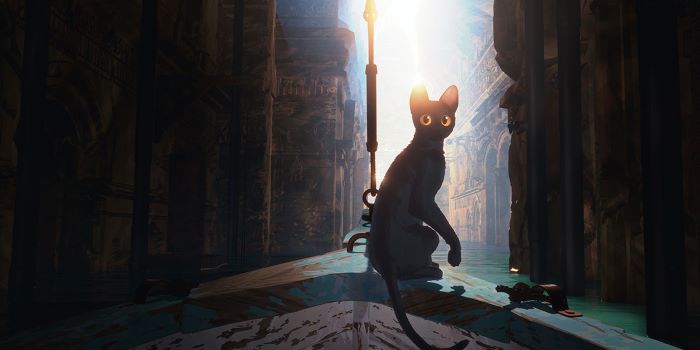![]() The power of animated storytelling knows no bounds, and such is the case with Flow, an awe-inspiring odyssey about a group of animals surviving a disaster together. It hooks you in without saying a word.
The power of animated storytelling knows no bounds, and such is the case with Flow, an awe-inspiring odyssey about a group of animals surviving a disaster together. It hooks you in without saying a word.
Even in a year full of animated gems like Inside Out 2 and The Wild Robot, Flow stands out. Devoid of human characters or dialogue, it encourages the viewer to actively interpret the on-screen apocalypse experienced by its feline lead. Characterization and worldbuilding are inferred rather than explicitly conveyed, achieved through atmosphere, music, and physical cues between its animal cast. This approach feels more akin to video games than traditional film. One can sense shades of Ico, Journey, and the indie cat game Stray in its methodology, but Latvian filmmaker Gints Zilbalodis (Away, 2019) imbues the story with just enough personality to keep Flow’s plot engaging while sidestepping heavy-handed exposition.
The black cat protagonist remains unnamed. It lives comfortably in a wooded cottage with no sign of a previous owner, though the abundance of feline-themed statues and woodwork suggests whoever once lived there loved cats. Life is simple until a flood suddenly blasts through the forest, covering everything in water and rising steadily with each passing minute. Before long, the cat’s home is completely submerged, forcing the feline to seek refuge on a passing sailboat to survive this biblical catastrophe.
The cat doesn’t travel alone. Upon boarding the small boat, it discovers a laid-back capybara already using it as a home. Soon, the duo is joined by other companions: a happy-go-lucky Labrador retriever who once belonged to the pack of dogs that terrorized the cat, a lemur obsessed with shiny knickknacks scavenged from various ruins, and a crane who, after a tragic incident, begins to embrace the camaraderie of this makeshift family. A massive whale occasionally emerges from the ocean. Its features resembling an ancient leviathan from mythology rather than a typical underwater creature.
Despite occasional supernatural elements, the story’s focus on ordinary animals is part of its charm. The motley crew has a loose goal: to pilot the boat toward a titanic rock structure visible in the distance. However, Flow is more interested in the in-between moments—acts of companionship and survival where animals from different points on the food chain learn to co-exist. Their grunts, meows, barks, squawks, and screeches evolve into a decipherable language. (With careful observation of body motions and head tilts, viewers can even “translate” their interactions.) Rendered in a quasi-cel-shaded animation style, each animal has a distinct personality. Meanwhile, the outside world’s fate is hinting at through submerged ruins, discarded statues, and the remnants of a lost city.
The visual style evokes the worldbuilding philosophy of PlayStation’s “Team Ico” games, teasing just enough architecture to suggest the presence of an ancient culture while keeping the lore enigmatic. This combination of visual storytelling, worldbuilding, and the evocative score by Zilbalodis and Rihards Zalupe gives Flow a rich atmosphere. It shifts seamlessly from whimsical to perilous, never losing its sense of intrigue. The score and visuals also highlight the film’s sense of humor. One moment, the cat clumsily tries to stand upright like the crane to bond with it; the next, it’s distracted by light refracted from the lemur’s mirror—because, of course, it’s still a cat. These comedic beats are effective and never break the film’s immersion.
That is the beauty of Flow. Its minimalist direction keeps it grounded and adventurous, appealing to both adults and children. It’s not just for pet lovers but for animation enthusiasts seeking something that challenges the imagination and pushes the boundaries of mainstream cinema. With its animal-centric narrative, Flow achieves something profoundly human.

















Leave A Comment